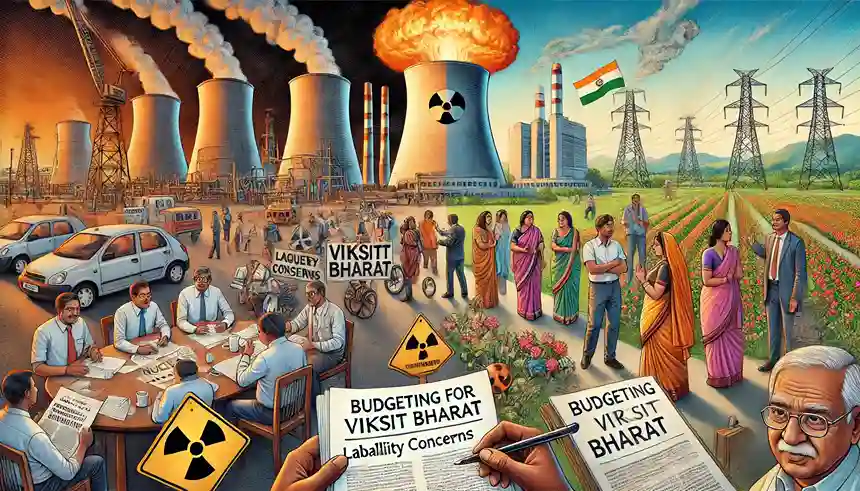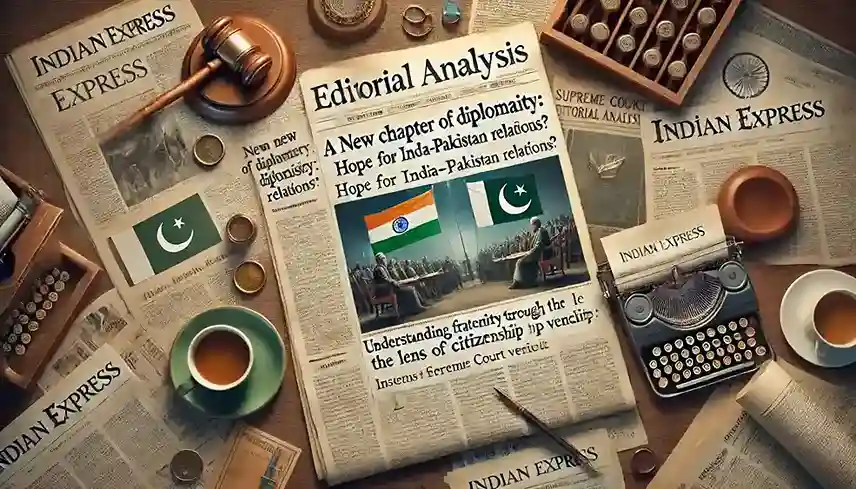Analysis of Indian Express Editorial 1: A Kind of Hope
Context:
Indian Foreign Minister S. Jaishankar’s visit to Pakistan during the Shanghai Cooperation Organisation (SCO) summit sparked discussions about the future of India-Pakistan relations. Could this be a turning point for the two neighbors, or is it just a brief moment of diplomatic courtesy? This article examines the context and implications of the recent interactions between the two countries.
A More Diplomatic Tone from Pakistan?
Jaishankar’s visit to Islamabad was marked by an unexpected warmth and courtesy from Pakistan’s establishment. In stark contrast to earlier diplomatic engagements, which often carried a more abrasive tone, this meeting seemed to reflect a possible shift in Islamabad’s approach. While Jaishankar remained steadfast on India’s key positions, he handled the situation with the grace required in such a delicate scenario.
This softer approach from Pakistan raises the question: Is Islamabad reevaluating its diplomatic stance, perhaps realizing that hostility may no longer be the most effective strategy?
- Analysis of The Hindu Editorial – February 13, 2025

- Analysis of The Hindu Editorial – February 12, 2025

- Analysis of The Hindu Editorial – January 1, 2025

- Analysis of The Hindu Editorial – December 31, 2024

- Analysis of The Hindu Editorial – December 19, 2024

Pakistan’s Internal Struggles: A Driving Factor for Change
Political and Economic Turmoil
Pakistan is currently facing a whirlwind of internal crises. The country is dealing with severe political instability, economic difficulties, rising sectarian violence, and growing public frustration with military repression. The government, along with the military, is under significant pressure to stabilize the nation. This internal chaos may be pushing Pakistan’s leadership to reassess its foreign policy, especially concerning India, in order to refocus on resolving its internal issues.
Contrasting Diplomatic Styles: Bhutto vs. Jaishankar
A comparison between Jaishankar’s visit to Pakistan and the behavior of Pakistan’s former Foreign Minister, Bilawal Bhutto Zardari, during the 2023 SCO meeting in Goa is illuminating. Bhutto’s combative attitude reflected Pakistan’s traditional hardline stance, particularly following India’s abrogation of Article 370 in Jammu and Kashmir. However, Jaishankar’s recent visit to Islamabad was notably different.
During Jaishankar’s visit, there was a marked effort on the part of the hosts to engage in private discussions and maintain a more positive atmosphere. This lack of resentment, combined with a willingness to communicate, indicates that Pakistan might be moving away from a purely adversarial approach, at least for the time being.
What’s Driving Pakistan’s Diplomatic Shift?
Internal Pressures
Pakistan’s deepening political and economic turmoil may be forcing its government to adopt a more pragmatic stance. With the nation reeling from inflation, economic collapse, and widespread unrest, the leadership may be seeking to shift its focus from confrontation with India to addressing these pressing internal issues. Stabilizing the country is likely seen as a higher priority than continuing a hardline foreign policy.
A Pragmatic Approach from the Sharif Government
Under Prime Minister Shehbaz Sharif and the influence of former Prime Minister Nawaz Sharif, Pakistan appears to be embracing a more pragmatic approach. The government seems to be moving away from populist rhetoric and recognizing the potential benefits of engagement with India. Strengthening economic ties and fostering regional stability could be a way to address some of Pakistan’s internal challenges.
India’s Global Rise
Another factor influencing Pakistan’s changing stance may be India’s growing presence on the global stage. As India’s economy continues to expand and its influence in regional and international affairs grows, Pakistan might see the advantage of fostering a cooperative relationship with its neighbor. Maintaining hostility toward a rising regional power like India could be detrimental to Pakistan’s long-term interests.
A Path Forward: India’s Strategy Towards Pakistan
India’s policy towards Pakistan has historically been shaped by three major schools of thought: Realists, Liberal Institutionalists, and Constructivists. Each offers a different approach to managing relations with Pakistan.
- Realists, often represented by figures like Subedars, focus on national security and advocate for a tough stance, which has been the dominant narrative during the Modi administration.
- Liberal Institutionalists, also known as Saudagars, emphasize the potential for trade, economic connections, and people-to-people relationships as paths toward peace.
- Constructivists, or Sufis, promote dialogue, cultural exchanges, and reconciliation, believing that addressing historical grievances is key to building trust and achieving long-term peace.
A Balanced Approach
Incorporating elements from all three perspectives could help India craft a more nuanced and effective strategy toward Pakistan. While it is essential to remain cautious and prioritize national security, there is potential to explore other avenues of cooperation, such as economic partnerships and cultural exchanges.
Small steps, such as confidence-building measures and incremental trade agreements, could lay the groundwork for a more peaceful and stable relationship. However, India must also keep a close eye on developments in Pakistan, ensuring that any moves towards cooperation align with broader regional stability.
Conclusion: Cautious Optimism or a Diplomatic Mirage?
While there are reasons to be cautiously optimistic about the recent diplomatic developments between India and Pakistan, the road ahead remains uncertain. Pakistan’s internal turmoil and shifting leadership dynamics suggest that Islamabad may be reevaluating its foreign policy. However, whether this will lead to sustained improvement in bilateral relations is yet to be seen.
For India, adopting a flexible, yet firm, approach that blends security concerns with opportunities for cooperation could pave the way for a more balanced and fruitful relationship with its neighbor. As the region watches closely, only time will tell if this moment of diplomatic warmth will lead to lasting peace or fade into yet another missed opportunity.
- [PDF] Kiran SSC 10600+ General Awareness Book English
![[PDF] Kiran SSC General Awareness Book English](https://savepdf.in/wp-content/uploads/2024/12/PDF-Kiran-SSC-10600-General-Awareness-Book-English-1156x650.webp)
- [PDF] – Manorama Yearbook 2025: A Comprehensive Guide to Knowledge and Exam Success

- [PDF] Blackbook 25000+ GA English Medium
![[PDF] Blackbook 25000+ GA English Medium](https://savepdf.in/wp-content/uploads/2024/11/PDF-Blackbook-25000-GA-English-Medium-1156x650.webp)
- [PDF] Reasoning Made Easy – Download Now
![[PDF] Reasoning Made Easy](https://savepdf.in/wp-content/uploads/2024/11/Reasoning-Made-Easy-1156x650.webp)
- [PDF] Police Recruitment Challenger – Download Now
![[PDF] Police Recruitment Challenger](https://savepdf.in/wp-content/uploads/2024/11/Police-Recruitment-Challenger-1156x650.webp)
Table: Key Factors Influencing Pakistan’s Shift in Diplomacy
| Factor | Description |
|---|---|
| Internal Turmoil | Political instability, economic collapse, and public unrest are forcing Pakistan to reassess. |
| Pragmatism of Sharif Government | The Sharif leadership favors a practical approach, focusing on governance over populism. |
| India’s Growing Global Influence | India’s economic and diplomatic rise is prompting Pakistan to consider more cooperative ties. |
Analysis of Indian Express Editorial 2: About Fraternity
Context: Citizenship Debate in Assam
The Supreme Court’s recent verdict on Section 6A of the Citizenship Act has reignited the national debate on citizenship, identity, and fraternity. The ruling, which upheld the constitutional validity of Section 6A, has brought the citizenship question in Assam to the forefront, offering a broader and more inclusive perspective on what it means to be a citizen of India.
Let’s break down the key points of the verdict and its implications, especially for Assam, a state deeply intertwined with migration issues.
Supreme Court’s Verdict on Section 6A: A Liberal Outlook on Citizenship
In a 4-1 majority decision, the Supreme Court upheld the constitutionality of Section 6A of the Citizenship Act. This ruling plays a pivotal role in determining who is considered a foreigner in Assam. The court adopted a liberal and expansive interpretation of citizenship, taking into account both historical context and the need for inclusivity.
The judgment emphasizes that citizenship should not be viewed through a narrow lens but rather as a principle that encompasses diverse communities, especially in a state like Assam, which has witnessed waves of migration throughout its history.
The Assam Accord: A Historical Agreement
The roots of Section 6A can be traced back to the Assam Accord of 1985, a landmark agreement between the central government, led by Prime Minister Rajiv Gandhi, and the All Assam Students’ Union (AASU). The accord aimed to resolve the issue of illegal migration into Assam by establishing a cut-off date for citizenship.
Under Section 6A, foreign migrants of Indian origin who entered Assam between January 1, 1966, and March 25, 1971, were eligible to apply for Indian citizenship. This provision was crucial for maintaining peace in the region while also addressing the concerns of the indigenous population.
- [PDF] “Arihant Computer Awareness Book 1” – Free Download
![[PDF] Arihant Computer Book.pdf” – Free Download for Competitive Exams](https://savepdf.in/wp-content/uploads/2025/04/PDF-Arihant-Computer-Book.pdf-–-Free-Download-for-Competitive-Exams-1040x650.webp)
- [PDF] The Pragmatic Programmer by David Thomas and Andrew Hunt

- [PDF] Structure and Interpretation of Computer Programs
![[PDF] Structure and Interpretation of Computer Programs](https://savepdf.in/wp-content/uploads/2024/12/PDF-Structure-and-Interpretation-of-Computer-Programs-1157x650.webp)
- [PDF] Computer Fundamentals by Anita Goel – Free Download
![[PDF] Computer Fundamentals by Anita Goel – Free Download](https://savepdf.in/wp-content/uploads/2024/11/Computer-FundameComputer-Fundamentals-by-Anita-GoelComputer-Fundamentals-by-Anita-Goelntals-by-Anita-Goel-1156x650.png)
- [PDF] – Mainframe Systems Programming: An Introduction – Download Now
![Mainframe Systems Programming: An Introduction – [PDF]](https://savepdf.in/wp-content/uploads/2024/10/PDF-–-Mainframe-Systems_20241004_162243_0000-1156x650.webp)
Challenges to Section 6A: The Debate Over Equality and Fraternity
Arguments Against Section 6A
Critics of Section 6A argued that it violated the constitutional principles of equality and fraternity. The petitioners claimed that the section created a special citizenship framework for Assam, which differs from the rules applicable to the rest of the country. This, they argued, violated the Right to Equality (Article 14), as it set different standards for different regions.
Further, the petitioners contended that Article 29, which safeguards the cultural and educational rights of India’s minorities, was also infringed. They argued that allowing large-scale migration into Assam threatened the indigenous communities’ ability to preserve their culture and identity.
A Broader Interpretation of Fraternity
In his response, Justice Surya Kant delved into the Constituent Assembly debates to provide a broader understanding of fraternity in the Indian constitutional context. According to Justice Kant, the Indian concept of fraternity is inclusive and aligns with the goals of social justice. It goes beyond national boundaries and embraces the diversity of India’s population. Therefore, the idea of fraternity does not exclusively focus on indigenous communities but seeks to create a harmonious coexistence among all citizens.
The March 25, 1971 Cut-off Date: A Historical Context
The Supreme Court upheld March 25, 1971 as the cut-off date for determining citizenship in Assam. This date is significant for two main reasons:
- It corresponds with the date set by the Illegal Migrants (Determination by Tribunals) Act, 1983, which formalized the process for identifying and expelling illegal migrants in Assam.
- March 25, 1971, marks the beginning of Operation Searchlight, a brutal crackdown by the Pakistani military on the nationalist movement in East Pakistan (now Bangladesh). Many who fled to Assam during this period were escaping violence and persecution. The court viewed these migrants as similar to the Partition refugees, for whom India had historically adopted a liberal stance.
By endorsing this cut-off date, the court acknowledged the unique circumstances of the time and supported a more compassionate approach to migration issues, emphasizing the importance of humanitarian considerations.
The Way Forward: Citizenship and Equality in Modern India
The Supreme Court’s decision introduces a dynamic interpretation of citizenship, one that balances the principles of equality and upliftment with historical and regional realities. This expansive view has important implications for future discussions on citizenship, particularly concerning individuals who migrated to Assam after 1971.
Future Implications
The ruling sets the stage for broader debates on how India should approach citizenship in a region that has historically been a melting pot of cultures, identities, and migrations. As India continues to grapple with questions of identity, migration, and rights, the principles highlighted in this verdict will likely resonate in future legal and political debates.
Table: Key Points of the Supreme Court Verdict on Section 6A
| Issue | Key Points |
|---|---|
| Validity of Section 6A | The Supreme Court upheld Section 6A, affirming its constitutional validity through a 4-1 verdict. |
| Assam Accord | The 1985 agreement set the foundation for Section 6A, establishing a framework for granting citizenship. |
| Challenges to Section 6A | Petitioners argued it violated equality and endangered Assam’s indigenous culture. |
| Fraternity | Justice Kant emphasized an inclusive view of fraternity, aligning with social justice principles. |
| Cut-off Date: March 25, 1971 | The court upheld this cut-off, citing historical reasons such as the 1971 Bangladesh crisis. |
Conclusion: A Balance of Citizenship, Equality, and Fraternity
The Supreme Court’s verdict on Section 6A of the Citizenship Act has opened up a broader dialogue on what it means to be an Indian citizen, particularly in regions with complex histories like Assam. By endorsing a more inclusive interpretation of citizenship and fraternity, the court has highlighted the importance of balancing historical realities with the constitutional principles of equality and social justice.

